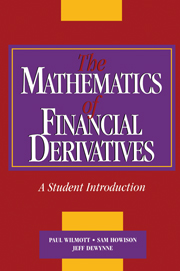Book contents
- Frontmatter
- Contents
- Preface
- Part One Basic Option Theory
- 1 An Introduction to Options and Markets
- 2 Asset Price Random Walks
- 3 The Black–Scholes Model
- 4 Partial Differential Equations
- 5 The Black–Scholes Formulæ
- 6 Variations on the Black–Scholes Model
- 7 American Options
- Part Two Numerical Methods
- Part Three Further Option Theory
- Part Four Interest Rate Derivative Products
- Hints to Selected Exercises
- Bibliography
- Index
6 - Variations on the Black–Scholes Model
from Part One - Basic Option Theory
Published online by Cambridge University Press: 05 June 2012
- Frontmatter
- Contents
- Preface
- Part One Basic Option Theory
- 1 An Introduction to Options and Markets
- 2 Asset Price Random Walks
- 3 The Black–Scholes Model
- 4 Partial Differential Equations
- 5 The Black–Scholes Formulæ
- 6 Variations on the Black–Scholes Model
- 7 American Options
- Part Two Numerical Methods
- Part Three Further Option Theory
- Part Four Interest Rate Derivative Products
- Hints to Selected Exercises
- Bibliography
- Index
Summary
Introduction
We have now completed the Black–Scholes analysis of vanilla European call and put options. Although the formulre that we have derived are useful, there are many more complicated situations in which they are not adequate. This chapter is devoted to a number of straightforward extensions of the Black–Scholes analysis. We see how to incorporate dividends, how to deal with forward and futures contracts, and how to put time-varying parameters into the Black–Scholes equation, but we still use straightforward calls and puts as the building blocks. Later chapters deal with American and ‘exotic’ options which have more complex contract structures.
There is one possible direction of generalisation that we do not discuss in this book: we assume that all our models are driven by stochastic processes of the type discussed previously. We do not use models that, for example, postulate some essential nonlinearity in the underlying markets, as might be attributed to feedback from derivatives markets into asset prices. Although there is some evidence that markets are not as close to our models as we would like, the Black–Scholes world is a good enough approximation for most purposes, both theoretical and practical.
Options on Dividend-paying Assets
Dividend Structures
Many assets, such as equities, payout dividends. These are payments to shareholders out of the profits made by the company concerned, and the likely future dividend stream of a company is reflected in today's share price.
- Type
- Chapter
- Information
- The Mathematics of Financial DerivativesA Student Introduction, pp. 90 - 105Publisher: Cambridge University PressPrint publication year: 1995



